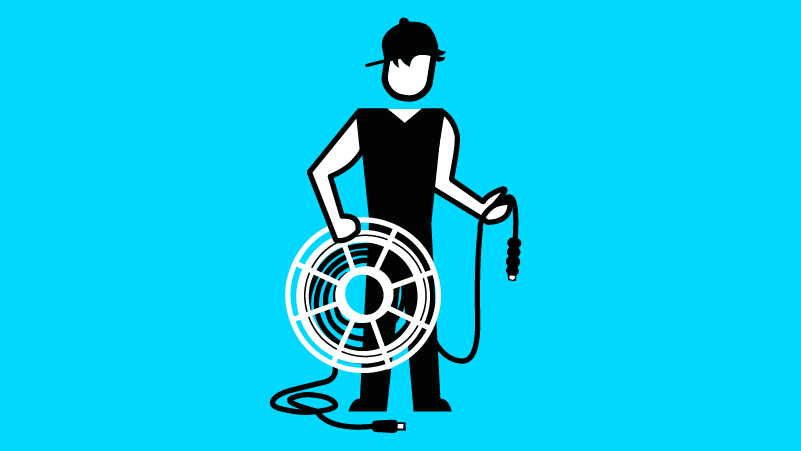Unscripted TV
OB rigger
Also known as: Rigger-driver, Access operative

What does an OB rigger do?
OB riggers lay out the cables for the cameras on an outside broadcast (OB). They are often the first on the site and usually the last to leave, sometimes rigging overnight to avoid crowds.
During pre-production, the head of the rigging crew, the rigger supervisor, usually attends the location recce with the engineering manager and the camera supervisor. Together they work out the cable runs for the cameras and plan the best way to connect all the different vehicles. This recce is particularly important if it’s a new location.
On a major outside broadcast, like Formula 1 or the anniversary of D-Day, there can be many miles of cabling serving 20 to 30 cameras, perhaps more. Every cable has to be carefully planned, particularly if it’s crossing a pavement or busy road, and made safe so it doesn’t cause accidents.
Once the plans have been set, the rigging crew sets up. As well as laying the cables, they may also help the camera crew to position the cameras, and during the show they can support the camera team by ‘cable-bashing’ - this means making sure the cables on a moving camera don’t get tangled or become a hazard.
The rigging team needs to respect the environment in which they’re working. They could be rigging in areas of high security – like Buckingham Palace, the Houses of Parliament or a military airfield. In all cases they are aware of the rules and regulations required to work on site and will need to pass the accreditation checks.
OB riggers are often known as rigger-drivers, because they have HGV licences and drive the outside broadcast vehicles to and from the location. These are some of the largest and most expensive vehicles on the road, so it requires a great deal of experience. It’s important that all the vehicles arrive in exactly the right order: on a big OB there may be 20 or more large vehicles packed into a small parking area.
OB riggers should not be confused with riggers in the film industry. Film industry riggers are specialist scaffolders who set up the structures for the lighting and scenery of a TV or film production, which is a very different job from driving and laying cables.
Most OB riggers are freelancers. The work involves a lot of travelling, which can be exciting, but can also take a toll on family life.
Watch and read
What’s an OB rigger good at?
• Rigging techniques: interpret designs, plan carefully every cable’s position, select the appropriate equipment needed for the rig, be able to use the necessary lifting kit and accessories
• Health and safety: know the health and safety legislation, follow the correct manual handling procedures, wear the right protective equipment, be responsible for your own safety and the safety of the public
• Head for heights: have steady feet and a steady hand whilst working above the crowds, be able to work high up in stadiums and outdoor buildings but never lose your head
• Driving: have an HGV driver’s licence and extensive driving experience
• Communication: deal with occasional problems with tact and by talking through issues, liaising with local groups like police to find solutions that allow the show to go on, work as part of a team
Who does an OB rigger work with?
Riggers report to the rigging supervisor or unit manager. During filming they need to communicate with camera operators and grips while ‘cable-bashing’. Sometimes they need to liaise with local authorities.
How do I become an OB rigger?
Some OB riggers enter the industry through training programmes for riggers and rigger-drivers offered by outside broadcast companies. Others start out as HGV drivers in other industries. Once they have their licence and experience, they are in a strong position to apply for OB rigging jobs.
At school or college:
You don’t need to get A-levels or Highers to be a rigger, but if you want to take them, make sure you study subjects you enjoy.
You might also be interested in the following Level 3 vocational qualifications:
• NOCN Cskills Awards Diploma in Accessing and Rigging
• Edexcel NVQ Diploma in Accessing Operations and Rigging
Ask for work experience or training:
Employers in the outside broadcast industry are either broadcasters, such as the BBC, Sky and ITV, or specialist outside broadcast companies that service the broadcasters. Some offer training schemes for riggers. Check out their websites. Contact them and ask if they do work experience or training.
Get an HGV driving licence:
You might want to increase your chances of employment by getting an HGV driving licence first - and then moving into the television industry. Check out the National Careers Service advice on how to become a large goods vehicle driver.
Apply for jobs:
Keep your eye on the websites of outside broadcast companies and broadcasters. If you have the driving experience they are looking for, apply for the roles. Ask them to keep your CV on file.
You might also be interested in…
Working in the construction department for Film and TV, eventually becoming a construction manager.







